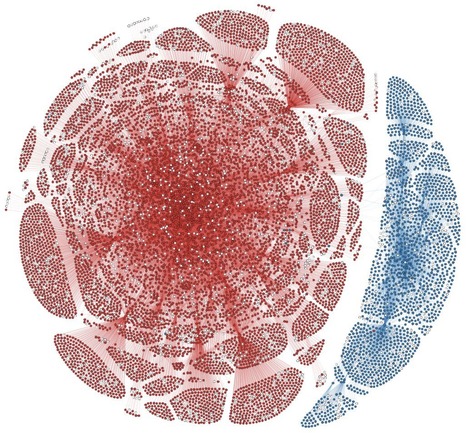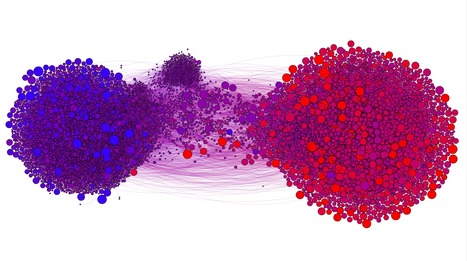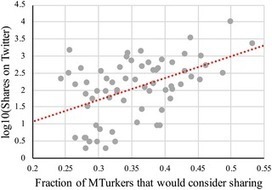 Your new post is loading...
 Your new post is loading...

|
Suggested by
Fil Menczer
|
Francesco Pierri, Brea L. Perry, Matthew R. DeVerna, Kai-Cheng Yang, Alessandro Flammini, Filippo Menczer & John Bryden
Scientific Reports volume 12, Article number: 5966 (2022) Widespread uptake of vaccines is necessary to achieve herd immunity. However, uptake rates have varied across U.S. states during the first six months of the COVID-19 vaccination program. Misbeliefs may play an important role in vaccine hesitancy, and there is a need to understand relationships between misinformation, beliefs, behaviors, and health outcomes. Here we investigate the extent to which COVID-19 vaccination rates and vaccine hesitancy are associated with levels of online misinformation about vaccines. We also look for evidence of directionality from online misinformation to vaccine hesitancy. We find a negative relationship between misinformation and vaccination uptake rates. Online misinformation is also correlated with vaccine hesitancy rates taken from survey data. Associations between vaccine outcomes and misinformation remain significant when accounting for political as well as demographic and socioeconomic factors. While vaccine hesitancy is strongly associated with Republican vote share, we observe that the effect of online misinformation on hesitancy is strongest across Democratic rather than Republican counties. Granger causality analysis shows evidence for a directional relationship from online misinformation to vaccine hesitancy. Our results support a need for interventions that address misbeliefs, allowing individuals to make better-informed health decisions. Read the full article at: www.nature.com

|
Suggested by
Fil Menczer
|
Christopher Torres-Lugo, Kai-Cheng Yang, Filippo Menczer A growing body of evidence points to critical vulnerabilities of social media, such as the emergence of partisan echo chambers and the viral spread of misinformation. We show that these vulnerabilities are amplified by abusive behaviors associated with so-called ''follow trains'' on Twitter, in which long lists of like-minded accounts are mentioned for others to follow. This leads to the formation of highly dense and hierarchical echo chambers. We present the first systematic analysis of U.S. political train networks, which involve many thousands of hyper-partisan accounts. These accounts engage in various suspicious behaviors, including some that violate platform policies: we find evidence of inauthentic automated accounts, artificial inflation of friends and followers, and abnormal content deletion. The networks are also responsible for amplifying toxic content from low-credibility and conspiratorial sources. Platforms may be reluctant to curb this kind of abuse for fear of being accused of political bias. As a result, the political echo chambers manufactured by follow trains grow denser and train accounts accumulate influence; even political leaders occasionally engage with them.

|
Suggested by
mohsen mosleh
|
Gordon Pennycook, Ziv Epstein, Mohsen Mosleh, Antonio Arechar, Dean Eckles, David Rand The spread of false and misleading news on social media is of great societal concern. Why do people share such content, and what can be done about it? In a first survey experiment (N=1,015), we demonstrate a disconnect between accuracy judgments and sharing intentions: even though true headlines are rated as much more accurate than false headlines, headline veracity has little impact on sharing. We argue against a “post-truth” interpretation, whereby people deliberately share false content because it furthers their political agenda. Instead, we propose that the problem is simply distraction: most people do not want to spread misinformation, but are distracted from accuracy by other salient motives when choosing what to share. Indeed, when directly asked, most participants say it is important to only share accurate news. Accordingly, across three survey experiments (total N=2775) and an experiment on Twitter in which we messaged N=5,482 users who had previously shared news from misleading websites, we find that subtly inducing people to think about the concept of accuracy increases the quality of the news they share. Together, these results challenge the popular post-truth narrative. Instead, they suggest that many people are capable of detecting low-quality news content, but nonetheless share such content online because social media is not conducive to thinking analytically about truth and accuracy. Furthermore, our results translate directly into a scalable anti-misinformation intervention that is easily implementable by social media platforms.

|
Suggested by
Fil Menczer
|
The study of social phenomena is becoming increasingly reliant on big data from online social networks. Broad access to social media data, however, requires software development skills that not all researchers possess. Here we present the IUNI Observatory on Social Media, an open analytics platform designed to facilitate computational social science. The system leverages a historical, ongoing collection of over 70 billion public messages from Twitter. We illustrate a number of interactive open-source tools to retrieve, visualize, and analyze derived data from this collection. The Observatory, now available at osome.iuni.iu.edu, is the result of a large, six-year collaborative effort coordinated by the Indiana University Network Science Institute.
|

|
Suggested by
Fil Menczer
|
We analyze the relationship between partisanship, echo chambers, and vulnerability to online misinformation by studying news sharing behavior on Twitter. While our results confirm prior findings that online misinformation sharing is strongly correlated with right-leaning partisanship, we also uncover a similar, though weaker, trend among left-leaning users. Because of the correlation between a user’s partisanship and their position within a partisan echo chamber, these types of influence are confounded. To disentangle their effects, we performed a regression analysis and found that vulnerability to misinformation is most strongly influenced by partisanship for both left- and right-leaning users. Read the full article at: misinforeview.hks.harvard.edu

|
Suggested by
mohsen mosleh
|
Mohsen Mosleh, Gordon Pennycook, David G. Rand There is an increasing imperative for psychologists and other behavioral scientists to understand how people behave on social media. However, it is often very difficult to execute experimental research on actual social media platforms, or to link survey responses to online behavior in order to perform correlational analyses. Thus, there is a natural desire to use self-reported behavioral intentions in standard survey studies to gain insight into online behavior. But are such hypothetical responses hopelessly disconnected from actual sharing decisions? Or are online survey samples via sources such as Amazon Mechanical Turk (MTurk) so different from the average social media user that the survey responses of one group give little insight into the on-platform behavior of the other? Here we investigate these issues by examining 67 pieces of political news content. We evaluate whether there is a meaningful relationship between (i) the level of sharing (tweets and retweets) of a given piece of content on Twitter, and (ii) the extent to which individuals (total N = 993) in online surveys on MTurk reported being willing to share that same piece of content. We found that the same news headlines that were more likely to be hypothetically shared on MTurk were also shared more frequently by Twitter users, r = .44. For example, across the observed range of MTurk sharing fractions, a 20 percentage point increase in the fraction of MTurk participants who reported being willing to share a news headline on social media was associated with 10x as many actual shares on Twitter. We also found that the correlation between sharing and various features of the headline was similar using both MTurk and Twitter data. These findings suggest that self-reported sharing intentions collected in online surveys are likely to provide some meaningful insight into what content would actually be shared on social media.

|
Suggested by
mohsen mosleh
|
Mohsen Mosleh, Gordon Pennycook, Antonio Arechar, David Rand Social media is playing an increasingly large role in everyday life. Thus, it is of both scientific and practical interest to understand behavior on social media platforms. Furthermore, social media provides a unique window for social scientists to deepen our understanding of the human mind. Here we investigate the relationship between individual differences in cognitive reflection and behavior on Twitter in a sample of large N = 1,953 users recruited via Prolific Academic. In doing so, we differentiate between two competing accounts of human information processing: an “intuitionist” account whereby reflection plays little role in daily life, and a “reflectionist” account whereby reflection (and, in particular, overriding intuitive responses) does play an important role. We found that people who score higher on the Cognitive Reflection Test (CRT) – a widely used measure of reflective thinking – were more discerning in their social media use: They followed more selectively, shared news content from more reliable sources, and tweeted about weightier subjects. Furthermore, a network analysis indicated that the phenomenon of echo chambers, in which discourse is more likely with like-minded others, is not limited to politics: we observe “cognitive echo chambers” in which people low on cognitive reflection tend to follow the same set of accounts. Our results help to illuminate the drivers of behavior on social media platforms, and challenge intuitionist notions that reflective thinking is unimportant for everyday judgment and decision-making.
When networks depend on other networks, such as a communications network that relies on a power grid, failure can cascade back and forth between the two. This behavior may explain sudden breakdowns in interacting systems. Thus, the effects of an attack on a single node can reduce an übernetwork that starts with 12 operating nodes to just four. Once studied solo, systems display surprising behavior when they interact.
Via FuturICT
|



 Your new post is loading...
Your new post is loading...















WhatsApp: +380 96 386 6267 ) TOP QUALITY COUNTERFEIT MONEY FOR
SALE. DOLLAR, POUNDS, EUROS AND OTHER CURRENCIES AVAILABLE.
OUR WEBSITE BELOW:
https://banksnote.com
https://banksnote.com
https://banksnote.com
https://banksnote.com
https://banksnote.com
https://banksnote.com
https://banksnote.com
https://banksnote.com
https://banksnote.com
https://banksnote.com
https://banksnote.com
https://banksnote.com
WhatsApp: +380 96 386 6267 ) GET 100% UNDETECTABLE BANK NOTES AND
QUALITY DOCUMENTS.https://banksnote.com
VISIT OUR WEBSITE AT:
https://banksnote.com
https://banksnote.com
https://banksnote.com
https://banksnote.com
https://banksnote.com
https://banksnote.com
https://banksnote.com
https://banksnote.com
https://banksnote.com
https://banksnote.com
https://banksnote.com
https://banksnote.com
https://banksnote.com
https://banksnote.com
https://banksnote.com
https://banksnote.com
https://banksnote.com
https://banksnote.com
https://banksnote.com
https://banksnote.com
https://banksnote.com
https://banksnote.com
https://banksnote.com
https://banksnote.com
https://banksnote.com
https://banksnote.com
https://banksnote.com
https://banksnote.com
https://banksnote.com
https://banksnote.com
https://banksnote.com
https://banksnote.com
https://banksnote.com
https://banksnote.com
https://banksnote.com
https://banksnote.com
https://banksnote.com
https://banksnote.com
https://banksnote.com
https://banksnote.com
https://banksnote.com
https://banksnote.com
https://banksnote.com
https://banksnote.com
https://banksnote.com
https://banksnote.com
https://banksnote.com
https://banksnote.com
https://banksnote.com
https://banksnote.com
https://banksnote.com
https://banksnote.com
https://banksnote.com
https://banksnote.com
https://banksnote.com
https://banksnote.com
https://banksnote.com
https://banksnote.com
https://banksnote.com
https://banksnote.com
https://banksnote.com
https://banksnote.com
https://banksnote.com
https://banksnote.com
https://banksnote.com
https://banksnote.com
https://banksnote.com
https://banksnote.com
https://banksnote.com
https://banksnote.com
OUR WEBSITE BELOW:
https://banksnote.com
https://banksnote.com
https://banksnote.com
https://banksnote.com
https://banksnote.com
https://banksnote.com
https://banksnote.com
EUR - Euro : https://banksnote.com
USD - US Dollar: https://banksnote.com
DNR - DINAR: https://banksnote.com
GBP - British Pound: https://banksnote.com
INR - Indian Rupee :https://banksnote.com
AUD - Australian Dollar: https://banksnote.com
CAD - Canadian Dollar: https://banksnote.com
AED - Emirati Dirham: https://banksnote.com
ZAR - Rand: https://banksnote.com
CHF - Swiss Franc:https://banksnote.com
CNY - Chinese Yuan Renminbi: https://banksnote.com
MYR - Malaysian Ringgit: https://banksnote.com
THB - Thai Baht: https://banksnote.com
NZD - New Zealand Dollar: https://banksnote.com
SAR - Saudi Arabian Riyal: https://banksnote.com
QAR - Qatari Riyal: https://banksnote.com
FOR MORE INFORMATION'S, CONTACT US BELOW>>>>>
VISIT OUR WEBSITE AT: https://banksnote.com
https://banksnote.com
https://banksnote.com
https://banksnote.com
https://banksnote.com
https://banksnote.com
VISIT OUR WEBSITE AT:
https://banksnote.com
https://banksnote.com
https://banksnote.com
https://banksnote.com
https://banksnote.com
https://banksnote.com
https://banksnote.com
https://banksnote.com
https://banksnote.com
https://banksnote.com
https://banksnote.com
https://banksnote.com
https://banksnote.com
https://banksnote.com
https://banksnote.com
https://banksnote.com
https://banksnote.com
https://banksnote.com
https://banksnote.com
https://banksnote.com
https://banksnote.com
https://banksnote.com
https://banksnote.com
https://banksnote.com
https://banksnote.com
https://banksnote.com
https://banksnote.com
https://banksnote.com
https://banksnote.com
https://banksnote.com
https://banksnote.com
https://banksnote.com
https://banksnote.com
https://banksnote.com
https://banksnote.com
https://banksnote.com
https://banksnote.com
https://banksnote.com
https://banksnote.com
https://banksnote.com
https://banksnote.com
https://banksnote.com
https://banksnote.com
https://banksnote.com
https://banksnote.com
https://banksnote.com
https://banksnote.com
https://banksnote.com
https://banksnote.com
https://banksnote.com
https://banksnote.com
https://banksnote.com
https://banksnote.com
https://banksnote.com
https://banksnote.com
https://banksnote.com
https://banksnote.com
https://banksnote.com
https://banksnote.com
Whats-app Number:: +380 96 386 6267
Whats-app Number:: +380 96 386 6267
Email: globalcurrency22@gmail.com
VISIT OUR WEBSITE AT:
https://banksnote.com
https://banksnote.com
https://banksnote.com
https://banksnote.com
https://banksnote.com
https://banksnote.com
https://banksnote.com